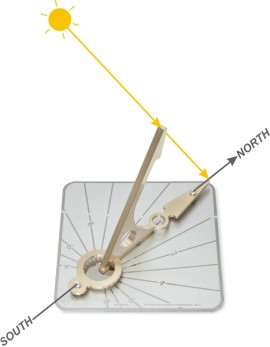Practical limits to accurate sundial time
A sundial is designed to read time by the sun. This places a broad limit of two minutes on accurate time because the shadow of the gnomon cast by the sun is not sharp. Looking from earth the sun is ½° across making shadows fuzzy at the edge.
 The actual construction of a sundial can be very accurate. The mathematics of how to design a sundial have been well understood since at least the eighteenth century. Instrument makers and designers have always had sufficient skills to create a good sundial.
The actual construction of a sundial can be very accurate. The mathematics of how to design a sundial have been well understood since at least the eighteenth century. Instrument makers and designers have always had sufficient skills to create a good sundial.
The installation of a sundial is often the weaker part. A sundial must be aligned true to the sun. In earlier times surveying technology was limited. In the present day alignment may not be too precise.
In order to show time accurate to ten minutes, a horizontal sundial must be adjusted to within 2° of its correct alignment. This is a practical target. A ten times (10x) more accurate target, for reading the sundial to one minute rather than ten minutes, needs high precision and skilled technique.
Before starting to align a sundial, the correct alignment to aim for must already be known. This means working out the longitude correction, and the equation of time for the calendar day. The exact time when the sun will be to the south can then be determined. The sundial is aligned to agree with that time. In the past, procedures were hard to make accurate.

Accurate alignment process for a vertical sundial, the gnomon shadow is at centre of the chart.
A sundial designed with time intervals of one hour, and well aligned, is an accurate sundial. A sundial with ten minute divisions, and carefully aligned, ought to be fully accurate. A sundial designed and correctly aligned to read to one minute is an exceptional instrument.
Many sundial instruments have been engraved with hour scales graduated down to two minutes or even one minute. By the standards of modern timekeeping most of these beautiful timepieces may not actually read accurate time.
Two case studies on the accuracy of a wall sundial are given here—Accurate Sundial for a Wall – two case studies.
Is the earth an accurate clock
Of course the concept of an accurate sundial relies on the idea that the earth is an accurate clock. It is because the earth is going round that the sun seems to travel through the sky. In fact the earth is a very accurate clock, rotating at constant speed. Up to 1972 it was the international standard for timekeeping, until the atomic clock took over.
Perturbations in the speed of rotation of the earth are very small indeed. They can be measured, and they do create very small differences between mean time and atomic time. Since the atomic clock is accurate to 1 second in 10 million years this is not so surprising! Any difference is resolved by introducing a leap second. In the forty years from 1972 to 2012, twenty-five leap seconds were added to atomic time. This has kept clocks in time with the sun, and prevented the natural day from slipping out of time.
